
AVUM burn 3 underway to raise apogee. Black cone is AVUM; to its right the white box is the Cressida dispenser, and far right is the MicroCarb sat.
26.07.2025 03:06 — 👍 43 🔁 3 💬 1 📌 1@spacepics.bsky.social
An account for appreciating the stars and all that orbits around them.

AVUM burn 3 underway to raise apogee. Black cone is AVUM; to its right the white box is the Cressida dispenser, and far right is the MicroCarb sat.
26.07.2025 03:06 — 👍 43 🔁 3 💬 1 📌 1
Rocks and sand. NASA/JPL-Caltech/MSSS/Kevin M. Gill
The workspace in front of the Mars Curiosity Rover following its Sol 4609 drive this week.
flic.kr/p/2riUsaA

Jet-streams, turbulent cloud regions, and layered cloud decks. NASA/JPL-Caltech/Kevin M. Gill
Saturn in orange+blue+ultraviolet false color in August 1981 during the Voyager 2 flyby.
flic.kr/p/2qFSd1C
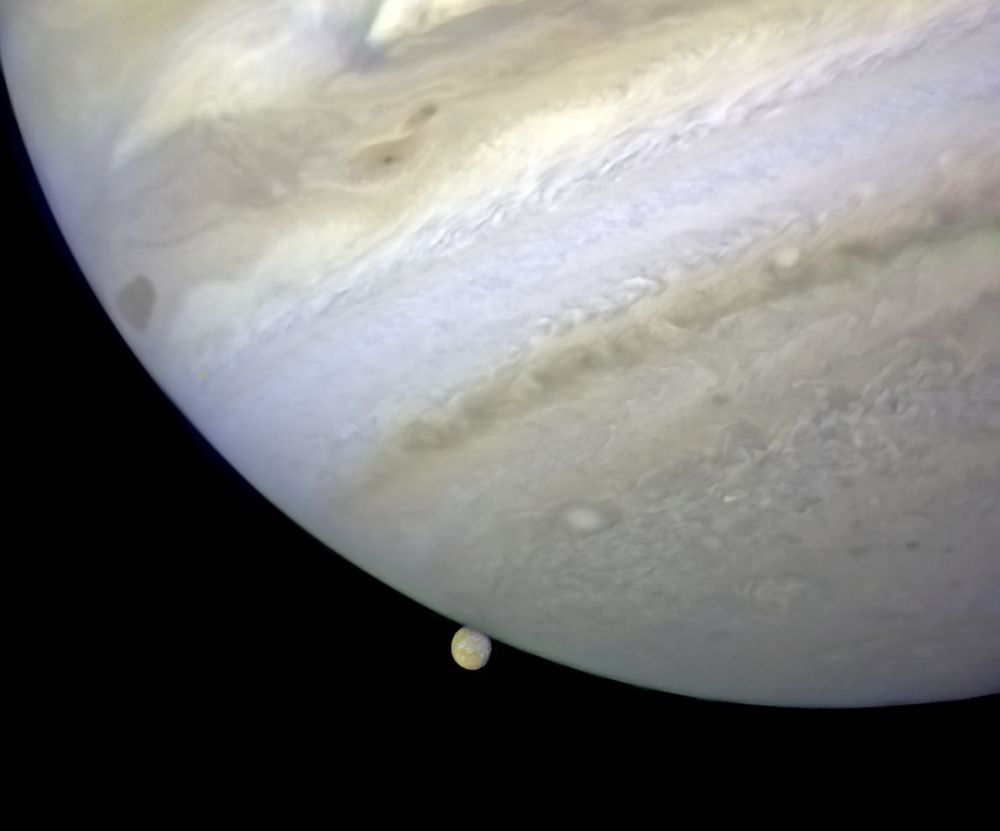
Jupiter and Io from Voyager 2
Jupiter and Io from Voyager 2 on June 25, 1979.
25.07.2025 14:02 — 👍 1381 🔁 172 💬 17 📌 8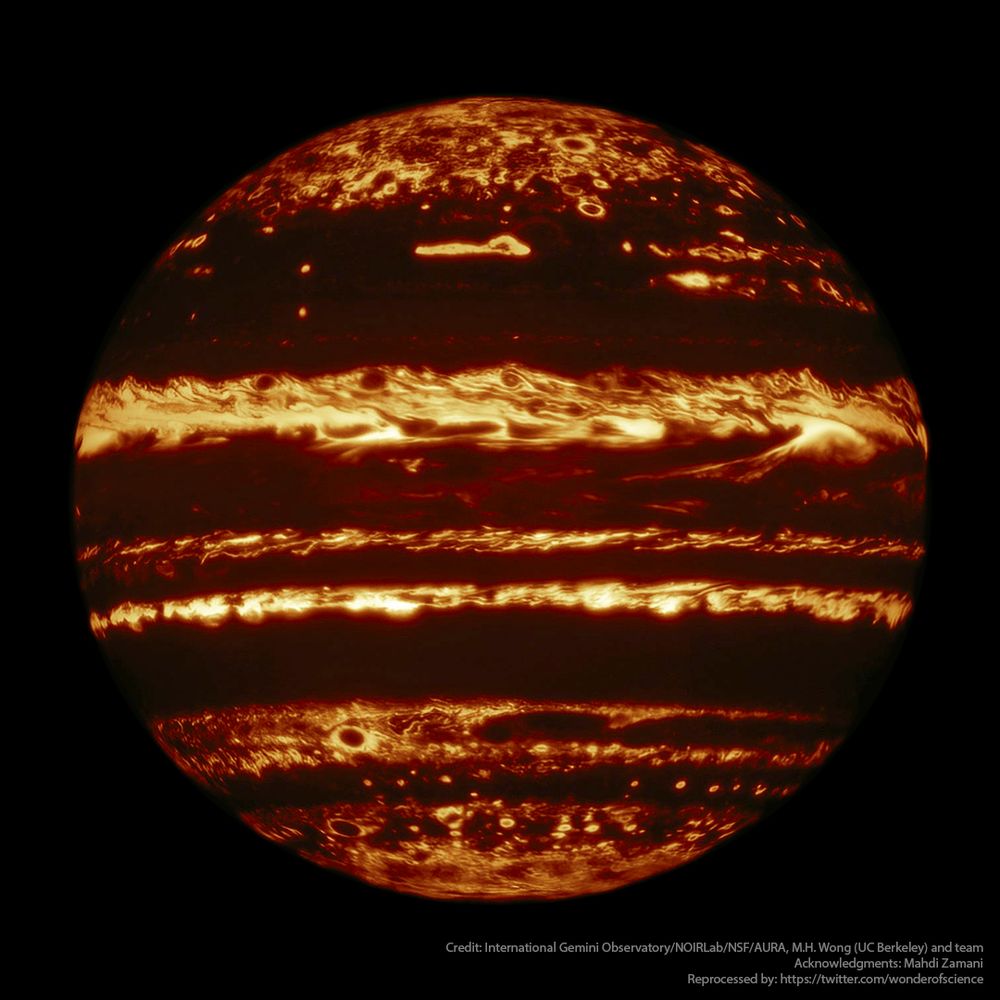
The planet Jupiter glowing in thermal infrared, as seen by the Gemini North telescope. The gas giant gives off more heat than it receives from the Sun.
Credit: International Gemini Observatory/NOIRLab/NSF/AURA M.H. Wong

The North America Nebula, NGC7000 in Cygnus
North America Nebula, imaged a few nights ago.
Processed in HOO with only 50 mins of integration (10 subs) per channel due to lack of darkness.
This is my first true narrowband mono image. Bit of a learning curve compared to what I'm used to, but good fun.
Compression has killed resolution a lot 😕
🔭

NGC 7000 in Cygnus, a wonderful and popular imaging target. Processed using the SHO "Hubble" palette
Rework of the North America nebula using the SHO Hubble palette.
My first true Hubble palette image!
Esprit 100mm refractor with ASI2600MM camera
🔭

The Great Orion nebula and the Running Man nebula. Another image from the recent Kelling Star Party.
Can't remember why, but I only took 36 mins of data, which is way too short, but turned out better than I expected
Can you see the running man?
#astronomy 🔭

Sh2-101. The Tulip nebula
My first try at the Tulip nebula in full SHO.
Taken 2 days before the shortest night of the year is not the best time to image!
Very noisy and needs lots more data, but I was quite pleased considering the conditions.
Roll on winter dark nights!
Esprit 100 and ASI2600MM.
50 mins per filter.
🔭

The 94.7% waning gibbous on Saturday.
13.06.2025 19:27 — 👍 95 🔁 8 💬 3 📌 0
Photo displaying planet Jupiter's southern hemisphere, including its largest storm, the Great Red Spot.
A bit of #Jupiter (NASA / JPL-Caltech / SwRI / MSSS / @kevinmgill.bsky.social)
09.06.2025 22:00 — 👍 2 🔁 1 💬 0 📌 0
This very deep image shows the two large interacting galaxies NGC 1549 and NGC 1553 in the Dorado Group. Located around 60 million light years away towards the southern constellation Dorado, it is one of the richest galaxy groups of the Southern Hemisphere with 46 members and tens of additional candidate members. The interaction of NGC 1549 and NGC 1553 appears to be in an early stage, and gravitational disruption in the form of irregular shells and tidal jet/arcs of material is clearly visible in both galaxies. Between the two large galaxies a small fuzzy blob with a faint spiral structure is visible; perhaps a remnant core from an earlier interaction, similar to the one observed in the shell elliptical galaxy NGC 3923 in Hydra. The largest of the galaxies is NGC 1549 to the North (top), discovered by John Herschel on 6 December 1835. It contains a supermassive black hole with an estimated mass between 390 and 810 million solar masses. To the south lies NGC 1553; the second brightest member of the Dorado Group. It is an impressive lenticular galaxy with a prominent soft isophotic ring surrounding another highly structured ring encircling the centre. A further very small spiral structure is visible in the core. In 2000 an inner torus-like dust lane about 3″ across was observed by the Hubble Space Telescope at the galaxy's center. The galaxy is thought to host an obscured central active galactic nucleus (AGN). In the lower left of the image lies the small edge-on spir...
Interacting Galaxies NGC 1549 and NGC 1553 in the Dorado Group - From Rolf Wahl Olsen - https://flic.kr/p/2jybqyW
10.06.2025 00:00 — 👍 160 🔁 21 💬 0 📌 0
Pluto and a grey halo around it.
pluto
12.06.2025 18:12 — 👍 145 🔁 28 💬 5 📌 0

did somebody say my name
10.06.2025 02:17 — 👍 2 🔁 0 💬 0 📌 0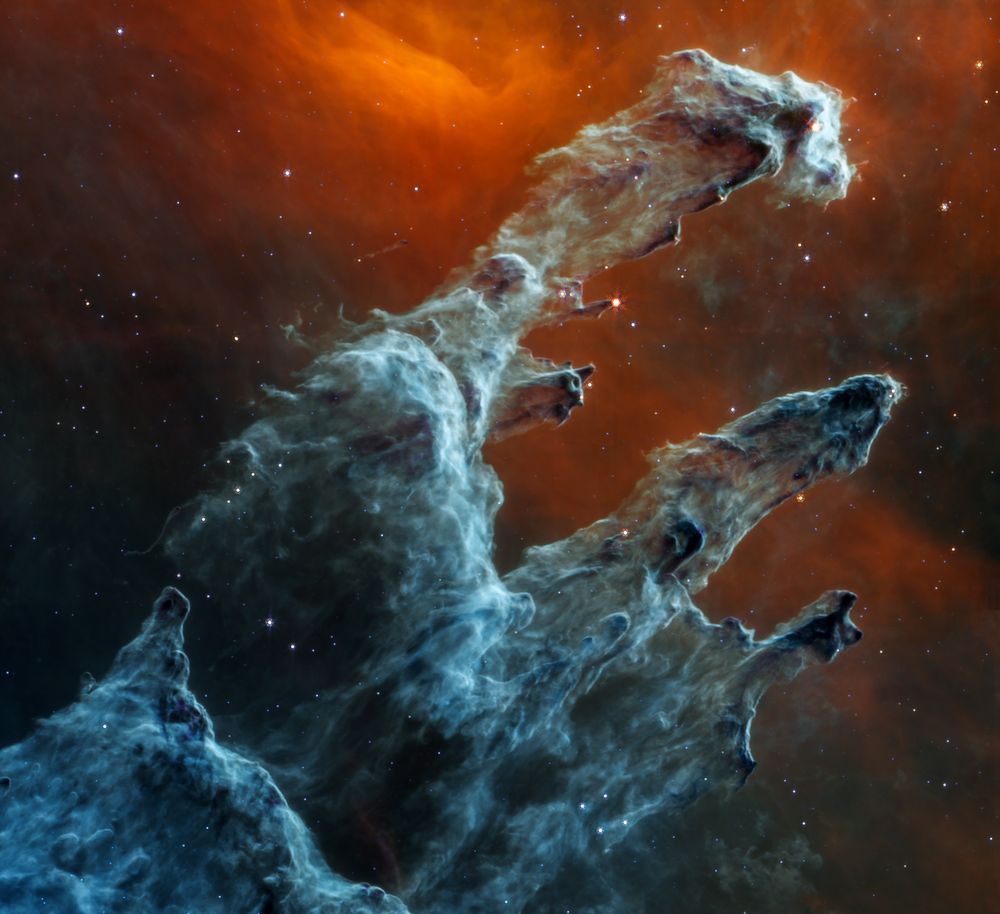
Many layers and pillars of semi-opaque gas and dust overlay one another. These regions appear light blue and dark gray-blue. The first pillar starts at the bottom left and extends to the top right. There is one prominent red star, with tiny spikes at its tip. Lower on this pillar, there are several darker areas of dust that jut out, many with bright red stars that appear as small red dots at their ends. Below the top pillar are two slightly smaller pillars, both ending in dark gray-blue regions. The second pillar has a dark arch that looks like an upside-down L halfway down. The background of this scene is washed in shades of red. Toward the top center is a V shape. At its lowest point, the V is a brilliant red. There are only several dozen tiny bright white and blue stars in this overall scene. Larger stars appear redder and are embedded in the pillars.
The Pillars of Creation, seen here in mid-infrared by #NASAWebb, adds to decades of research about star formation by helping astronomers analyze the densest dusts and gases of the region, and improving the precision of their star-formation models: bit.ly/45ayCYi 🔭 🧪
09.06.2025 14:17 — 👍 3999 🔁 555 💬 70 📌 28
A spiral galaxy from the Galaxy Zoo: Hubble project, classified by 51 volunteers.
A spiral galaxy, observed with the Hubble Space Telescope in the COSMOS survey.
It is at redshift 0.17 (lookback time 2.19 billion years) with coordinates (150.53265, 2.38079).
51 volunteers classified this galaxy in Galaxy Zoo: Hubble.

Photo of the area surrounding Jupiter's largest storm, dubbed the Great Red Spot.
A bit of #Jupiter (NASA / JPL-Caltech / SwRI / MSSS / Noriaki Okamoto)
08.06.2025 22:00 — 👍 2 🔁 1 💬 0 📌 0
NGC 6752 – Globular Cluster in Pavo One of the brightest and nearest globular clusters in our galaxy, NGC 6752 lies roughly 13,000 light-years away in the constellation Pavo. This dense sphere of ancient stars is estimated to be over 11 billion years old and contains multiple stellar populations, including blue stragglers and millisecond pulsars—signposts of complex internal dynamics and stellar evolution. Captured using RGB filters, this image reveals the dense core and surrounding halo of stars, tightly packed into a cluster only ~100 light-years across. NGC 6752 is a post-core-collapse cluster, and its high central concentration is evident even at modest image scale. Acquisition Details 🔴 Red: 33 × 180s 🟢 Green: 31 × 180s 🔵 Blue: 28 × 180s Total Integration: 5 hours Equipment • Telescope: Celestron EdgeHD 8" • Camera: ZWO ASI1600MM Pro • Mount: Sky-Watcher EQ6-R Pro • Filters: ZWO 36mm RGB • Accessories: Primaluce Lab EAGLE5S, ECCO 2, ESATTO 2", ZWO EFW 7×36mm, ZWO OAG-L • Software: NINA, PixInsight Visible from the Southern Hemisphere during winter months, NGC 6752 sits near the bright star Peacock and is a rewarding target for both visual observation and resolved stellar imaging.
This is NGC6752, one of the brightest and nearest globular clusters to us at 13,000ly away. Working on RCW58 that sets at 11:30pm local, so I hopped over to this nice cluster for the second half of the night and got about 4.5 hours on it. #astrophotography
@kat-astro-bot.bsky.social

JunoCam Jupiter images from PJ72. Exaggerated color/contrast. Full resolution version at flic.kr/p/2r9L22Y
09.06.2025 04:04 — 👍 42 🔁 12 💬 0 📌 1
Steve R Dodd ‘Rogue Planet 2’ (2024, acrylics on canvas board)
08.06.2025 00:09 — 👍 230 🔁 35 💬 1 📌 2 06.06.2025 23:14 — 👍 1 🔁 0 💬 0 📌 0
06.06.2025 23:14 — 👍 1 🔁 0 💬 0 📌 0
 06.06.2025 23:14 — 👍 1 🔁 0 💬 0 📌 0
06.06.2025 23:14 — 👍 1 🔁 0 💬 0 📌 0

Against a black background, a galaxy is seen from the side, nearly edge-on, stretching from the bottom left corner of to the top right corner. The galaxy appears in green and bright red, with colors wrapping around the arms of the galaxy. In the center of the galaxy is a bright aqua.

Against a black background, the center of a galaxy is shown, as it appears from the side. Long bright red filaments appear to be exploding from the green center, taking the shape of arms. A haze covers the center. Surrounding the center of the galaxy are bright red and dark green clouds.

Against a black background, the center of a galaxy is shown, as it appears from the side. Long bright purple filaments appear to be exploding from the near-white center, and look like arms. A haze covers the center. Surrounding the center of the galaxy are pink, blue, and bright green clouds. A blue orb appears beneath the center.
The core of the galaxy, seen by Hubble, is bursting with excitement! NGC 3079 reveals a bubble of hot gas rising from a cauldron of glowing matter. Other images show the core up close using visible light from Hubble (red/green) and X-ray from the Chandra observatory (blue). Credit: NASA/CXC/STScI 🔭
06.06.2025 15:05 — 👍 137 🔁 20 💬 0 📌 2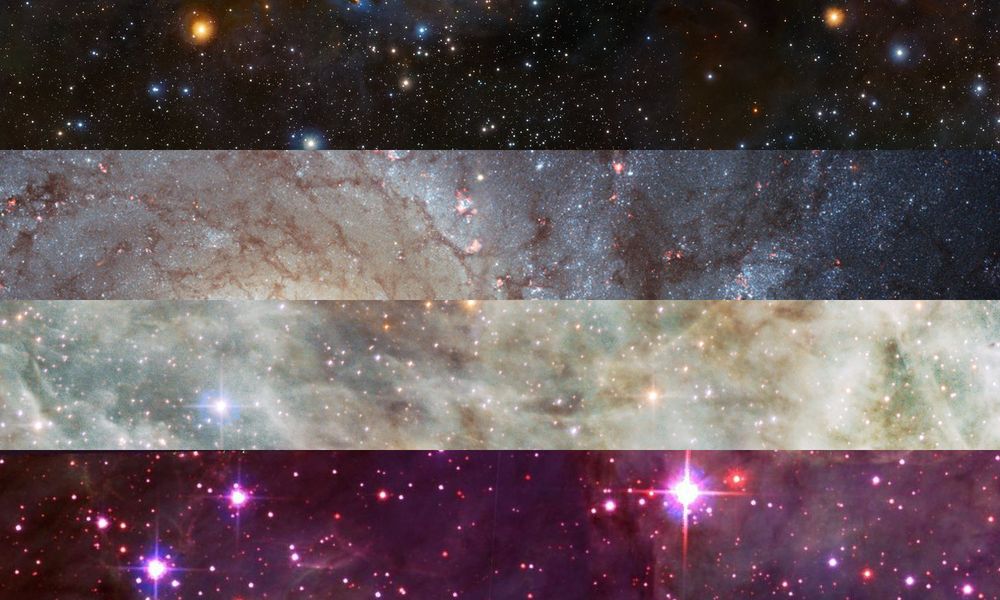
Asexual flag made from photos of galaxies
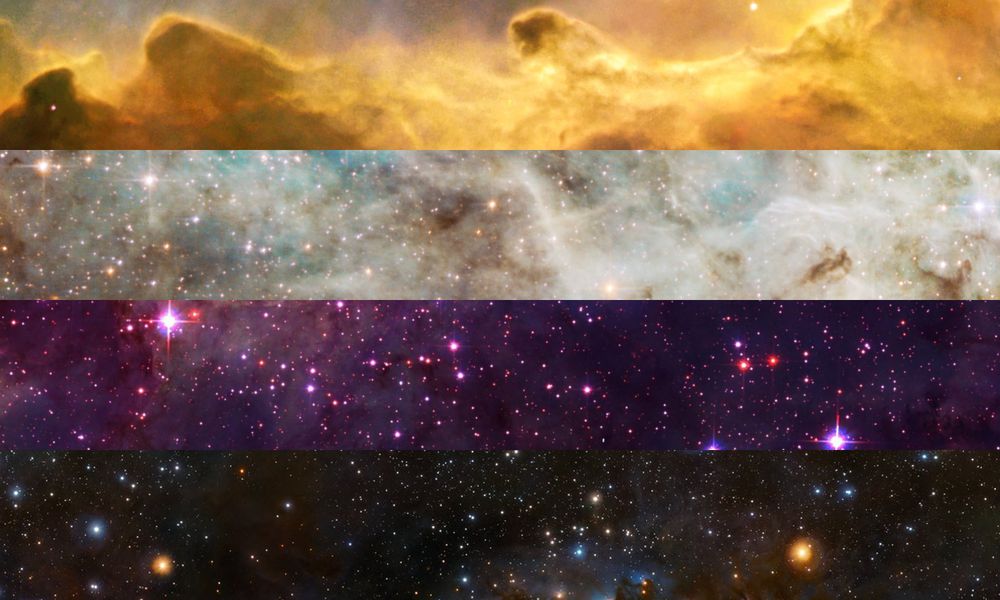
Non-binary flag made from photos of galaxies
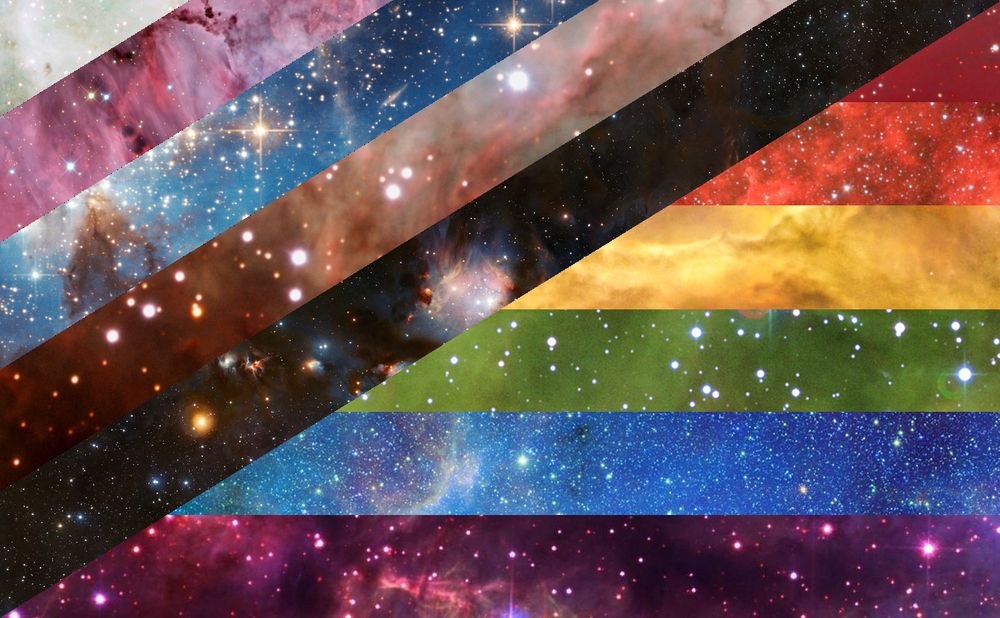
New Pride flag made from photos of galaxies
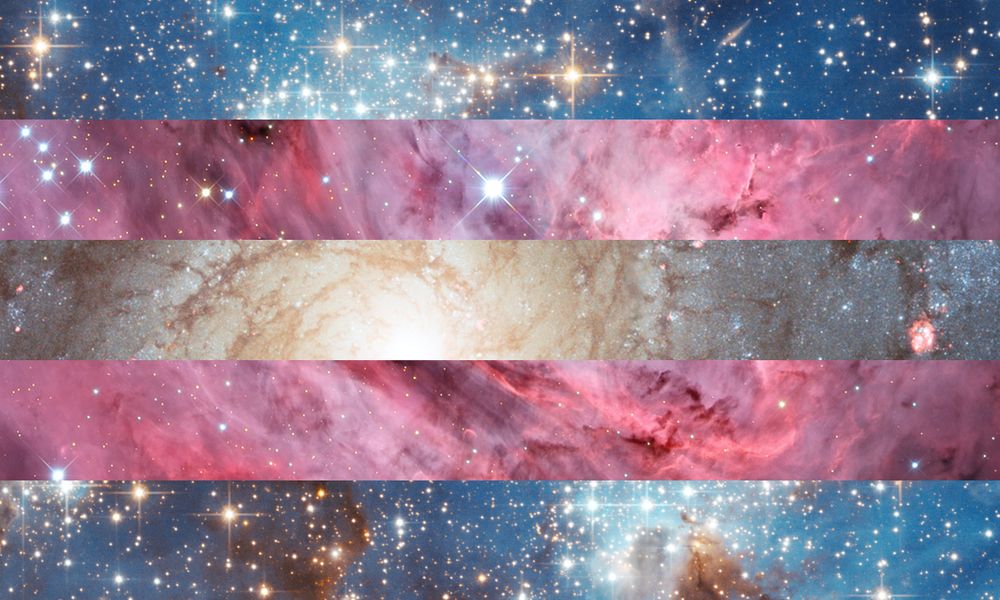
Transgender flag made from photos of galaxies
Happy Pride month, all! Way back in 2018 I made these galaxy pride flags. They were shared many thousands of times, featured on Vice, and even made their way onto book covers and into video games.
Here are the original ones I created (in no particular order!) so Bluesky can have them too. 💙

Wide-angle shot of Jupiter's southern polar region and subtropics, showcasing a striking colour variance, turbulence and a line of five bright circular storms nearer the equator.
A bit of #Jupiter (NASA / JPL-Caltech / SwRI / MSSS / Gerald Eichstädt)
06.06.2025 16:00 — 👍 3 🔁 1 💬 0 📌 0
The background is mostly dark. At the center is a dark orange-brown circle, surrounded by several blazing bright, thick, horizontal whiteish rings. This is Saturn and its rings. There are three tiny dots in the image—one to the upper left of the planet, one to the direct left of the planet, and the lower left of the planet. These are three of Saturn’s moons: Dione, Enceladus, and Tethys, respectively. There is a slightly darker tint at the northern and southern poles of the planet. The rings surrounding Saturn are mostly broad, with a few singular narrow gaps between the broader rings. There is an innermost, thicker ring, and next to that is a brighter, wider ring. Traveling farther outward, there is a small dark gap before another thicker ring. In the thicker ring, there is a narrow faint band. There is then an outermost, faintest, thinnest ring.
i still think about the jwst saturn picture a lot
05.06.2025 18:44 — 👍 508 🔁 66 💬 13 📌 1
Goodnight everyone
05.06.2025 02:08 — 👍 405 🔁 29 💬 14 📌 0
Credit - James Webb, NASA&CSA, J.Lee
05.06.2025 01:51 — 👍 1 🔁 0 💬 0 📌 0
A dazzling new kind of cosmic explosion, more energetic than anything seen before.
Extreme nuclear transients (ENT), which occur when massive stars—at least three times the mass of our Sun—are shredded by supermassive black holes. www.science.org/doi/10.1126/...

Earth from space, centered on Sudan, captured on Tuesday, June 3, 2025 at 9:15:24 AM by NASA's DSCOVR EPIC camera.
9:15:24 AM on Tuesday, June 3, 2025, over Sudan.
04.06.2025 23:00 — 👍 0 🔁 1 💬 0 📌 0